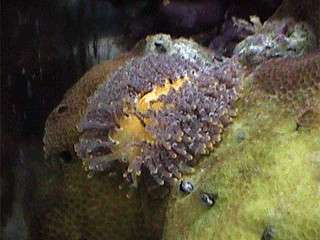Re: The coral-eating Phestilla lugubris
March 8, 2000
From: Kiichi Masu Chiba


Dear Bill,
Thanks for your prompt reply.
I herewith attach another two photos - pictures of his front view. You can find two pairs of tentacles on his face. I believe that he is Phestilla lugubris as you identified. It is just like the pics which you showed me.
Especially, they have got exactly same tentacles and the shape of bodies is almost same. He is beautiful and attractive. Is he an unusual kind?
I moved him to the soft coral tank with the Christmas tree worms rock. Because, this tank has another SPS. At that time, I carefully observed the worm rock to find another Phestilla lugubris. But, I could not find any of his friends even a small juvenile.
However, I have to choose him or the coral to die as you wrote. This is a very painful decision for me. I live in Central London, faraway from the real reef. I have no chance to return him to real reef safely. Moreover, It's so painful to see the coral turning into a skeleton even if the worms are happy.
..... However, I will keep Zira (This is Phestilla lugubris's Name, I named) in Soft Coral tank. I think, This is a providence of nature or obligation of reef keepers though it is sad that the coral will be eaten up.
How do you think of my decision as a biologist?
Kiichi Masu Chiba
kiichin@dircon.co.uk
Chiba, K.M., 2000 (Mar 8) Re: The coral-eating Phestilla lugubris. [Message in] Sea Slug Forum. Australian Museum, Sydney. Available from http://www.seaslugforum.net/find/2062Dear Kiichi,
From your new photos it is definitely Phestilla lugubris. I think I can see where part of the coral has been eaten. If you look on the right of the photo, the coral looks green. That is a thin layer of algae growing over a dead part of the coral skeleton. What do I think of your decision? I am biased in favour of the nudibranch so I think you made the right decision.
Is he unusual? They are probably quite common in the tropical Indo-West Pacific but seem to be subject to heavy predation by fish. In fact they do much better in aquaria, without fish bothering them, and grow to a much larger size than you normally find them in the wild.
Glad to have solved your puzzle,
Best wishes,
Bill Rudman.
Related messages
-
Coral-feeding Phestilla lugubris from East Timor
From: Brian Francisco, December 18, 2008 -
Aloha from Hawaii
From: Rita Bishop, April 24, 2003 -
Phestilla lugubris from Christmas Island
From: W.B. Rudman, May 4, 2002 -
My new companion (Phestilla)
From: Kiichi Masu Chiba, March 6, 2000 -
The coral-eating Phestilla lugubris
From: Bill Rudman, May 17, 1999
